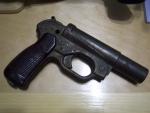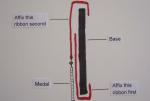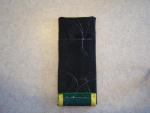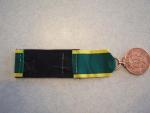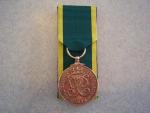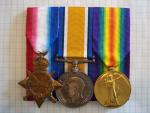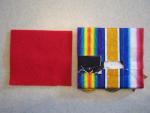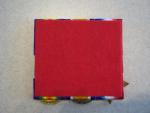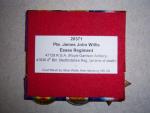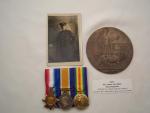-
Posts
6,486 -
Joined
-
Last visited
-
Days Won
10
Content Type
Profiles
Forums
Blogs
Gallery
Events
Store
Everything posted by Brian Wolfe
-
Hi Caz, I can't seem to locate my notes (renovations) on INdia regimental abbrevations at the moment. The only one I can recall of the three you are asking after is G.S. which stands for General Service. I do have some medals marked G.S. but once again due to renovations and the need to store furniture in the study I can't locate them. Perhaps Larry can shed some light on your question. Regards Brian
-
Hi Michael, I would think you are correct about the increase in the interest in their own country's history; that and the increased affluancy of some sections of the population. The other factor, in my opinion, is that there is a finite number of medals with an infinite number of collectors. It's the "American Buffalo" scenerio all over again. Collectors thought that there would always be an abundance of Indian Medals so this area went unnoticed for years (lucky for me), now more collectors are taking a second look and starting to collect. Regards Brian
-
Hi Paul, Look for Medals and Decorations of Independant India co-authored by Ed Haynes. It should be avasilable through an eBay seller. I would have to say the top book on the subject. Regards Brian
-

Even Blackadder can cause a political rift
Brian Wolfe replied to Nick's topic in The Great War 1914 to 1918
Grrrr. You always bring up that one paved street, Ok, samrt guy, we are about to build an addition to the buggy works and are installing those computing machines with the latest DOS package. Top that! Regards Brian -
I believe the Navy pattern has a neck chain rather than the single chain and hook arrangement of the police and army versions. The one from my collection (photo below) also has a much more robust attachment ring on the whistle and in this example the broad arrow is on the body of the whistle. Regards Brian
-
Excellent collection Caz, thanks for sharing them with us. It is my opinion based on observation that the medals of Independant India are getting harder to find. It was not that long ago that is seemed that the market was flooded with them but now that "flood" seems to have subsided. A friend of mine, and fellow GMIC member, living India, has told me that these medals are no longer available in the street markets as they once were. Regards Brian
-

Even Blackadder can cause a political rift
Brian Wolfe replied to Nick's topic in The Great War 1914 to 1918
Peter, How many times must we go over this? The ranking of importance is not linked to alphabetical order! Also, on most newly printed maps at least WE don’t have to “pencil in” the name of our little town. Regards Brian -

Even Blackadder can cause a political rift
Brian Wolfe replied to Nick's topic in The Great War 1914 to 1918
Hello Michael, Welcome to the forum, good to see another Canuck on board. I would have had to agree with your comment back in the 1970s but I do believe that today the respect and reverence for those who served and are serving today has returned somewhat. Of course that's what makes this a great country, being able to have two points of view without throwing bricks at on another. Regards Brian -
Hello Caz, You have the Marusthal clasp which means "Desert". It was instituted in 1984 for service of one year in a desert area or for aircrew for 10 sorties or forty hours of flying time over specified areas in western Rajasthan and western Haryana desert. [information from "Medals and Decorations of Independent India" by Edward S. Haynes and Rana T.S. Chhina]. Welcome to the interesting topic of Independent India's Medals and Decorations, it's good to see others with similar interests beginning their journey. Regards Brian
-

Luftwaffe Double barreled flare gun FL 24485 Relic
Brian Wolfe replied to Jock Auld's topic in Firearms & Ordnance
As a fellow who will attempt just about any type of retoration, I'd leave this one as it is. The damage and condition tells a story all by themselves. Regards Brian -

Luftwaffe Double barreled flare gun FL 24485 Relic
Brian Wolfe replied to Jock Auld's topic in Firearms & Ordnance
A hundred Euros sounds like a good enough price to me, even considering the damage. It would be a good dela more here in Canada. For those who might not know what the LP42 looks like... Regards Brian -

Luftwaffe Double barreled flare gun FL 24485 Relic
Brian Wolfe replied to Jock Auld's topic in Firearms & Ordnance
Hi Jock, What an interesting piece, I too wonder if that was flak damage or shrapnel from artillery. Thanks for posting it. Regards Brian -

Medal Mounting - Tutorial
Brian Wolfe replied to Brian Wolfe's topic in Great Britain: Orders, Gallantry, Campaign Medals
Thanks for your comment Larry. I'm glad you didn't miss the article. Regards Brian -

Medal Mounting - Tutorial
Brian Wolfe replied to Brian Wolfe's topic in Great Britain: Orders, Gallantry, Campaign Medals
Hello Eddie, A question that I can't answer. All of the documentation on him has him as a Gunner with the RGA then Private in both the Bedfordshire and Essex. I have a photo of him in the RGA and one with him with a group of both RGA and Essex. Process of elimination points to which soldier he is in the photos. There is a possibility that the photos were of other soldiers, however I think that is slim considering I got this straight from the famil and there is not a lot of random photos of different soldiers (all photos in their posession have this fellow in them). Sorry I can't answer your question. Regards Brian -

Medal Mounting - Tutorial
Brian Wolfe replied to Brian Wolfe's topic in Great Britain: Orders, Gallantry, Campaign Medals
Another Method Another method of court mounting medals found with some Indian and Pakistani medals, especially of the 1960s and 70s, is covered briefly below. This method works best if the back board is 3 inches rather than the British regulation 3½ inch long board. I have several medals and groups from India and Pakistan using this method, which I suspect was developed in order to conserve on the cost of ribbon. Since I had a single Pakistan Army Piper’s Trophy Medal on hand I decided to mount it up as an example. I’ll post the medal in the appropriate section with more description later. So far I have not been able to verify the ribbon as correct even though it was supplied with the medal. This ribbon is the same as the British Territorial Medal’s ribbon, while possible, it still needs verification. If anyone has information regarding this medal’s ribbon I would appreciate hearing from you. My reason for including this method is that you may encounter a single or group of medals, which may include British medals from WWII, using this method and decide that the mount is in such poor condition to require re-mounting. If you are anything like me you’ll want to preserve the integrity of the original and employ the same approach to court mounting. Sometimes good preservation and conservation requires repairs and, in my opinion, the item should be brought back to as close as possible to its original condition. Attach the bottom of the first ribbon first so that when you bring it around to the front the stitches do not show. Next sew the ribbon to the backing board. These stitches will show on the front of the mount but will be covered by the second ribbon. Next the second or top ribbon is affixed by sewing the top of the ribbon so that the stitches will not show once the ribbon is brought around to the front as shown in the drawing and in the photos below. You will notice that the medal is already attached to the ribbon; this is the best time to do this when using this method of mounting. Following the same procedures for the red felt back as in the initial portion of this tutorial you should have something that looks like the photos below. If you would like to try either or both of these methods and need more information please do not hesitate to contact me through a PM. Good luck and happy mounting. Regards Brian -

Medal Mounting - Tutorial
Brian Wolfe replied to Brian Wolfe's topic in Great Britain: Orders, Gallantry, Campaign Medals
Hi Paul, Will do. Brian -
Hi Rick, Before the wheel and long before man discovered fire there were drawers, man's greatest discovery; at least that would be what I would write in a book dealing with the history of mankind. Regards Brian
-

Medal Mounting - Tutorial
Brian Wolfe replied to Brian Wolfe's topic in Great Britain: Orders, Gallantry, Campaign Medals
Hi Paul, Thanks Paul,I appreciate your comments. I started out court mounting Indian medal groups, a lot being in pairs much like your example. The straight bar suspension madals are perfect for a first time project. The whole process is a lot easier than the tutorial would seem to make it. I was suprised at just how complicated it seemed when I read the final draft yet sitting down and doing the work never seemed to be that much of a deal. I hope you will give this a try and if you do I am sure you will be surprised at just how good it looks when finished. Regards Brian -

Medal Mounting - Tutorial
Brian Wolfe replied to Brian Wolfe's topic in Great Britain: Orders, Gallantry, Campaign Medals
HI Mike, Thanks for your comment. Most of the process is my own design and along the way I've studied other's work and started using glue more often as the final results were better than just sewing. I probably spend more time and effort on the base than necessary but no doubt due to one of my past professions (designing and building homes) I believe that if the base is not sound then the finished product will not be up to par either. Regards Brian -

Medal Mounting - Tutorial
Brian Wolfe replied to Brian Wolfe's topic in Great Britain: Orders, Gallantry, Campaign Medals
In order to make sure the bottoms of the medals protrude past the base ribbons here is a trick that might help you. Use a piece of graph paper and align the edge of the mount to a horizontal line. Now slide the mount down until the medal touches a horizontal line and make sure all of the rest of the medals are mounted to this line. Next you need to apply a piece of material to the back to protect the ends of the ribbons and to also make the area look neat and tidy. I have seen everything imaginable (within reason) used for the back; including, leather, black broad cloth, a thick piece of wood (balsa wood I believe) and even green duct tape. I like to use red felt. If you end up mounting quite a few groups this can almost become a trade mark of your work. Just remember to let the glue, under pressure, have time to cure, or dry after each step. You are almost finished. I like to add a card glued to the back with the details of the group, regimental number, name, rank, regiment etc. as well as any other pertinent information. In this case the soldier served in three different regiments, beginning with the Royal Garrison Artillery then being transferred to the Essex Regiment; the Essex was decimated so the survivors were assigned to the Bedfordshire Regiment, which is where he was when he was killed. You’ll notice that I also add my name as the person who put the mount together and my “general” address. This might sound a bit egotistical, however, if you are not proud enough of your work to have your name attached to a project then you should not have started it in the first place (in my opinion, as humble as that may or may not be). Other than pride of workmanship this tag keeps certain information with the mount where ever it may go in the future. It also serves as an identifier if the group is stolen and the culprit nabbed before he (or she) notices the tag and removes it. I was fortunate enough to uncover this gem along with all of the soldier’s papers and several photos of him and his fellow soldiers in a couple of different regiments. Below is the three items out of the many artifacts that came with this trio that I will display in the main collection. The balance of the paperwork, container and envelope for the memorial plaque along with other documentation will be stored in my archives filing cabinets. The Philosophy of Mounting Medals: This group of medals and supporting documents along with those of his brother-in-law, a pilot in the RFC were on their way to the landfill as garbage. The material regarding the pilot has photos, his records and pilot’s license along with many other documents. He joined very early in the war and therefore was one of the first RFC pilots. Surviving the war he worked in aircraft design as an aeronautics engineer throughout WW II and beyond until he retired. This material includes family photos and even passports. So in this case the historical account of these two men would have been now beneath dozens of feet of rotting garbage. To my way of thinking, what better way of honouring a service man that to court mount his medals and preserve these artifacts for future generations. I hope my long tutorial, and sermon at the end, will encourage you to attempt court mounting groups of medals yourself. Thanks for taking the time to read my submission. Regards Brian




